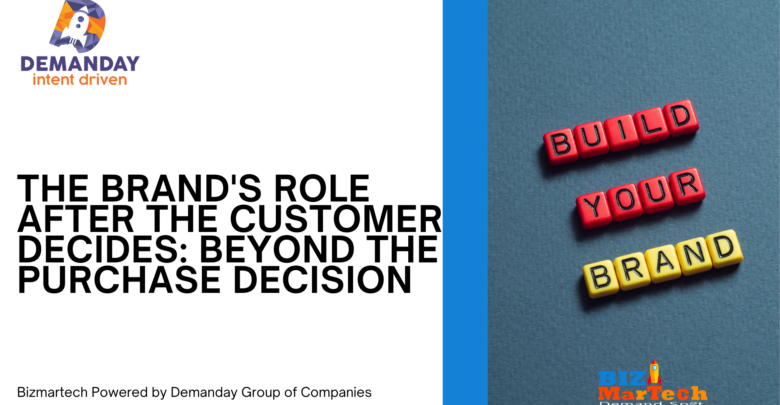Digital MarketingMarketing
The Brand’s Role After the Customer Decides: Beyond the Purchase Decision

In today’s competitive marketplace, the customer journey doesn’t end when a decision is made. In fact, the real challenge begins after the purchase decision has been made. Many brands focus on marketing tactics that influence customers to choose their product or service, but fewer address what happens after the customer has already decided. The role of marketing in this phase is critical — it’s not just about closing the deal but ensuring the customer’s continued satisfaction, loyalty, and advocacy.
1. Reinforce the Decision with Purposeful Communication
Once a customer has chosen your brand, the marketing focus shifts from persuasion to reassurance. Customers are often faced with post-purchase dissonance — a feeling of uncertainty about whether they made the right choice. This is particularly common with high-investment purchases, new product categories, or complex services.
Brands can step in to reinforce the decision through clear, consistent, and supportive communication. This can take the form of:
- Post-purchase follow-ups: Regular emails or messages thanking the customer for their purchase, offering tips, and addressing common concerns.
- Guided onboarding: Providing step-by-step instructions, videos, or live support to ensure customers use the product or service correctly and derive value from it.
- Exclusive content or offers: Make the customer feel special by offering them early access to new products, loyalty rewards, or educational content that enhances their experience.
The goal is to alleviate any lingering doubts and affirm the customer’s decision was the right one.
2. Foster Engagement Through Value-Added Experiences
A customer’s decision to purchase your product or service marks the beginning of a relationship, not the end. Brands should see this as an opportunity to engage customers in ways that go beyond the transactional. This can help build long-term loyalty and trust, ultimately turning customers into brand advocates.
- Personalized content and experiences: Leverage data and customer insights to offer tailored recommendations, exclusive product uses, or personal stories. When customers feel like a brand “gets them,” it fosters deeper engagement.
- Community building: Create spaces where customers can interact with the brand and each other. This could be an online forum, a social media group, or live events. Such communities offer customers a chance to bond over shared experiences, which can increase brand loyalty.
- Ongoing value delivery: A key aspect of a brand’s post-purchase role is to continue delivering value beyond the product itself. This could involve offering useful content, sharing tips and hacks, or even creating follow-up products or services that enhance the original purchase.
Brands that prioritize engagement and create value-driven experiences create more than just customers; they create lifelong advocates.
3. Support with Customer Service Excellence
Marketing should not just stop at the point of sale. A strong customer service strategy must be in place to assist customers after they’ve made their decision. Providing excellent post-purchase support is not only a necessity but also an opportunity for marketing teams to shape customer perception and strengthen the relationship.
- Seamless customer support: Offer multiple channels for support, from phone to chat to email, ensuring customers can get the help they need quickly and efficiently.
- Proactive problem-solving: Don’t wait for a complaint to arise. Anticipate potential issues and reach out proactively with solutions, especially if there are known pain points or common questions.
- Easy returns and exchanges: Ensure that any return or exchange process is hassle-free. A seamless return policy can build trust, even when things don’t go as planned, and turn a potentially negative experience into a positive one.
Customer service isn’t just a function of operations; it’s an essential part of the marketing ecosystem. How a brand treats its customers after the sale can be a key differentiator in a crowded marketplace.
4. Leverage Feedback for Continuous Improvement
Once the customer has made their purchase, their insights and feedback become invaluable. A key role of marketing in this phase is to collect, analyze, and act on customer feedback to improve both the product and the customer experience.
- Surveys and reviews: Send out post-purchase surveys, ask for feedback on social media, or request product reviews. This shows that the brand cares about the customer’s experience and is dedicated to improvement.
- Customer satisfaction metrics: Track Net Promoter Scores (NPS), Customer Satisfaction (CSAT), and other satisfaction metrics to gauge how well the brand is performing after the sale.
- Implement changes: Show customers that their input is valued by making meaningful changes based on their feedback, whether that’s improving product features or enhancing customer service processes.
By consistently improving based on customer feedback, brands can create a feedback loop that benefits both the business and the customer, creating a more agile and responsive marketing ecosystem.
5. Cultivate Loyalty and Advocacy
A customer’s decision to buy from your brand should ideally be the first step in a long-term relationship. One of the ultimate roles of post-purchase marketing is to transform satisfied customers into loyal ones, and loyal customers into brand advocates.
- Loyalty programs: Develop reward systems that incentivize repeat purchases, referrals, and engagement. These programs make customers feel valued and encourage them to keep coming back.
- Referral programs: Encourage satisfied customers to refer friends and family. Word-of-mouth marketing is one of the most powerful forms of marketing and can drive organic growth.
- Customer success stories: Showcase customer testimonials, case studies, or user-generated content to reinforce the value customers derive from your brand. This not only serves as social proof but also makes customers feel celebrated and part of a community.
A brand that successfully builds loyalty and advocacy enjoys sustainable growth, driven not just by repeat purchases, but by an army of vocal, passionate fans who are willing to promote your brand for you.
Conclusion
Marketing doesn’t end once a customer has made a decision — it’s just the beginning of a new phase in the relationship. After the decision, the brand’s role shifts from persuasion to nurturing: reinforcing the customer’s choice, deepening the relationship, delivering ongoing value, and turning customers into advocates.




